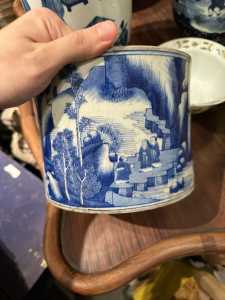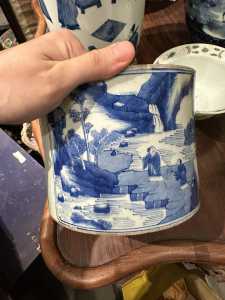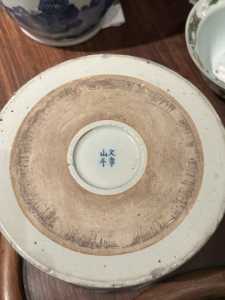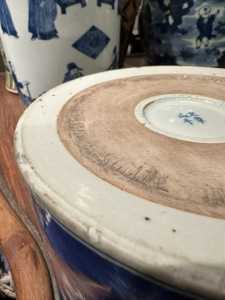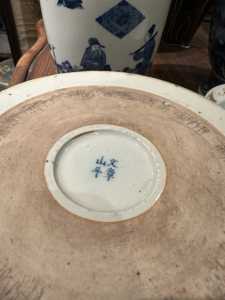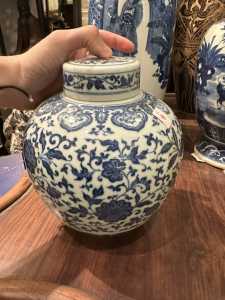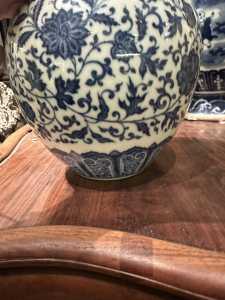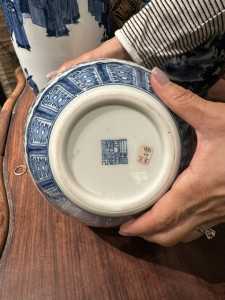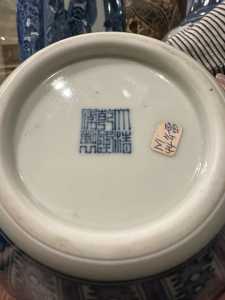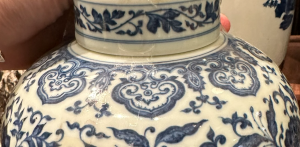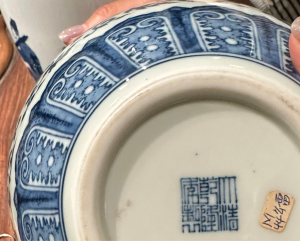The Chinese and Asian Art Forum. For Fans, Collectors and Dealers.
 Basic Rules For the BidAmount Asian Art Forum: Talk about whatever you want. You can even discuss and offer things that are for sale if they are authentic. Maximum image file size per post is 2 MB. Images of 700pxl x 700pxl are optimal if saved at a medium resolution. Be respectful of others and enjoy yourself. Click the YouTube link for a brief tutorial on using the forum. You can also EMBED Videos by cutting and pasting from You-Tube, Vimeo etc.
Basic Rules For the BidAmount Asian Art Forum: Talk about whatever you want. You can even discuss and offer things that are for sale if they are authentic. Maximum image file size per post is 2 MB. Images of 700pxl x 700pxl are optimal if saved at a medium resolution. Be respectful of others and enjoy yourself. Click the YouTube link for a brief tutorial on using the forum. You can also EMBED Videos by cutting and pasting from You-Tube, Vimeo etc.
NOTE: To post an item or add a new post, click open the category title from the FORUM LIST, and CLICK the Blue ADD TOPIC button.
Hi guys,
A newbie collector here. I recently bumped into these beauties at a local Chinese shop.
Kangxi brush pot looks very convincing, but I am not sure about period of the Qianlong marked jar. My first impression was that the jar is a later copy - footrim was wide and overall glaze color had blue-ish tone. However, the decoration was nice and the paste at the bottom was very clean, dense and soft, almost felt like clay.
I would love to hear your opinion. Thank you!
@shinigami Hi Brigit, thank you for the reply! I don't think the drawing is printed. Have a look at the patterns around shoulder and base, they are repeated and very similar, but every single one is different.
I am quite curious to know from which period is this jar from (I think it's unlikely to be of period).
Regarding the Kangxi brush pot, I am a bit leery of the chisel marks along the unglazed inner footrim. Any insights would be much appreciated 🙂
With Kangxi porcelain, I would recommend only buying it if you are confident in either the provenance it has or your own judgement it is old (with the understanding and acceptance of your potential fallibility). Now is not a great time to be buying Kangxi porcelain without clarity, especially if the financial consequence is significant for you.
Speaking for myself personally, I am not much of a fan of that brush pot. I kind of like the jar as the mark and foot rim are quite neat, but I do not know if it has any age.
With Japanese porcelain/metal for example you can still buy fairly carelessly and the items should be what they appear to be, but Chinese porcelain in particular requires very careful consideration. A modern piece is not a bad thing as an object in of itself, but you probably would not want to pay the price of an old piece for a modern piece.
I think even many years ago a beginner would almost necessarily make mistakes as a part of the learning process, now the potential for mistakes is even higher than before (a mistake being paying a price for an item that you would not be happy paying if you had deeper understanding of what the piece is, whether the items is old, vintage or modern). If you want to learn in depth for yourself I would recommend focusing on one small area at a time until you are confident and then gradually branching out, developing your own tastes as a collector. If you do not want to learn in depth I would heavily lean on impeccable provenance. Another angle is to not spend much money or indeed collect in other under appreciated fields that are easier to navigate.
@johnshoe @elm Thank you, John and Forest. I am really glad to have found this community, which is full of information and experienced people like you who share valuable insights. As a newbie, I am aware that my knowledge is very limited, so I typically do not spend a dime unless I am double triple confident.
John, may I ask how you were able to tell that the Kangxi brush pot is modern? I personally found it quite convincing.
Hi Jay,
I agree with the others to avoid buying these items. The jar is printed although the mark on the bottom seems to be hand painted. Still, quite new. The brush pot looks like the late Qing style of "Kangxi revival" although it may be newer.
I concur that you'll enjoy owning a real Kangxi piece albeit humbler: look for a repaired blue and white plate, for example. It's a great place to start. There are a lot of authentic Kangxi blue and white objects out there for pretty reasonable prices, especially saucers, small plates, repaired items.
Regards,
Steve
Hi Kim -
I would also concur with others to leave both pieces well alone ...
The painting style/cobalt shading footrim/base trimming on the brush pot are all wrong for Kangxi. Depending on condition, if acceptable as genuine this would be a mid 5 figure object ...
Much the same applies to the jar/cover, the mark writting of which contains numerous stroke errors ...
Walk away ...
Stuart
@terrancekim324 I'm glad you are trying to deepen your knowledge. The tricky part is trying to describe these things. What I have found more useful than verbal explanations is to simply look at tons of authentic examples and also fakes to see the differences and similarities. If you spend enough time doing this your eyes will begin to calibrate and then you are better situated to tell the difference. You will begin to notice the way they try to fake signs of age by adding small areas of damage and discoloration. You will begin to notice the subtle differences in the way they draw the images. The colors of the paste and enamels will look differently. Sometimes the shapes differ. All these differences can range between subtle to severe. The more subtle the differences the more experience you must have to tell the difference. And of course the absolute best thing is to handle as many authentic pieces as possible because the actual feel and presence of a piece is a significant aspect to help determine authenticity. After a couple of years of study you will start to know a little bit. But that's when you really need to be extra careful, because a little knowledge can get you into a lot of trouble when it comes to collecting Asian antiques! So study as much as possible and don't underestimate the fakers. And when in doubt, seek the advice of your mentors. If you do these things it will greatly improve your chances to succeed. Cheers! John
Enjoy the hunting!
Christie's site is excellent for looking at photos of authentic pieces. And, as Peter recommends, specialized books are also helpful. And as one of our members here pointed out, handling, too, although that's obviously not always possible at first.
Mistakes will probably be made; learn from them and keep them as cheap as possible. 😊
I love Kangxi blue and white and I've on a couple of occasions bought late Qing imitators by mistake. Turned out, that's OK; they have a charm all their own. And the bigger, nicer examples like vases are valuable in their own right.
That's a fun way to learn and better than looking at photos, for sure.
I really appreciate it when museums display dishes and bowls over mirrors so you can see the bottom.
I live in the Bay Area and the SF Asian Art Museum has an amazing collection of Chinese porcelain. Only trouble is they do *not* include items made for export.
Thanks for visiting "The BidAmount Asian Art Forum | Chinese Art"
If you sell on eBay, or have a shop feel free to post images and descriptions and links.
Check back often for discussion about the latest news in the Chinese art and antique world. Also find out about the latest Asian art auctions at Sotheby's, Christie's, Bonhams and Tajans.
Auction results for: fine porcelain, ceramics, bronze, jade, textiles and scholar's objects. As well as Japanese, Thai, Vietnamese and other Asian cultures.
Thank you,
Peter Combs
Topics and categories on The BidAmount Asian Art Forum | Chinese Art
Kangxi vases, Kangxi dishes and chargers, Kangxi ritual pieces, Kangxi scholar's objects, Qianlong famille rose, Qianlong enamels, Qianlong period paintings, Qianlong Emporer's court, Fine porcelain of the Yongzheng period. Chinese imperial art, Ming porcelain including Jiajing, Wanli, Xuande, Chenghua as well as Ming jades and bronzes.
The BidAmount Asian Art Forum | Chinese Art
A free Asian art discussion board and Asian art message board for dealers and collectors of art and antiques from China, Japan, Korea, Thailand, Cambodia, Vietnam and the rest of Asia. Linked to all of the BidAmount Asian art reference areas, with videos from plcombs Asian Art and Bidamount on YouTube. Sign up also for the weekly BidAmount newsletter and catalogs of active eBay listing of Chinese porcelain, bronze, jades, robes, and paintings.
The art of calligraphy - and for the ancient Chinese it certainly was an art - aimed to demonstrate superior control and skill using brush and ink. Calligraphy established itself as one of the major Chinese art forms during the Han dynasty (206 BCE - 220 CE), and for two millennia after, all educated men were expected to be proficient at it.
The Museum’s collections of Asian art span nearly five millennia and encompass the cultures of China, the Himalayas, India, Japan, Korea, and Southeast Asia. In 2007, the Museum launched an initiative to create dedicated galleries for the collection, beginning with a gallery for the arts of Korea ...
Chinese art is full of symbolism, in that artists typically seek to depict some aspect of a totality of which they are intuitively aware.
China Online Museum is the finest online museum of Chinese art. It features Chinese calligraphy, painting, ceramics, bronzes, carving, and other artworks.
Chinese Ceramics & Works of Art. Overview Upcoming auctions Contacts Auction results ... Christie’s sales of Chinese ceramics and works of art showcase centuries of Chinese history. Held throughout the year in London, New York, Paris and Hong Kong, they attract a wide audience of collectors and connoisseurs vying for pieces as diverse as ...
Explore Asian Art Week. Contact the Specialist Department. Chinese Paintings ... Senior Specialist, Head of Sale. [email protected]. Tel:+1 212 641 5760. Bid in-person or online for the upcoming auction:Fine Chinese Paintings on 10 September 2019 at New York. Bid in-person or online for the upcoming auction:Fine Chinese Paintings on 10 ...
Discover an abundance of must-see art from all corners of a vast continent at Christie’s NY Asian Art Week. From contemporary classical and Chinese paintings to works with exemplary provenance from the Art Institute of Chicago, our Rockefeller Paza galleries will be full of ancient treasures and contemporary masterworks in a salute to the vibrant arts of Asia.
Sold to benefit The Art Institute of Chicago’s Asian Art Acquisition Fund, the sale features 84 lots with a focus on Ming and Qing porcelains, and offers a rare insight into the taste for collecting Chinese ceramics and works of art in the Midwest from the end of the 19th century through the 1980s. Highlights include two Wanli wucai garlic-head vases, a Qianlong mark and period, blue and ...
Specialist, Chinese Paintings, Christie's London Dr Malcolm McNeill is a Specialist in Chinese Paintings at Christie’s, based in London. He previously worked as an assistant curator of the Chinese collections and the Victoria and Albert Museum in London, as a researcher at the British Museum, and as a translator and tour guide at the National Palace Museum in Taipei.
The Christie's Education 2020 Conference: The Chinese Art Market 18 Jun 2019 Christie’s Education is delighted to announce our first international academic conference in Asia which will take place in Hong Kong from 26-27 November 2020 at the Hong Kong Convention and Exhibition Centre and will run in parallel with Christie’s Hong Kong Autumn Auctions.
The summer Chinese Art sale in Hong Kong will feature works of art from several private collections, including Qing porcelains and textile from the collection of the legendary Chinese art dealer A. W. Bahr (1877–1959), fine gilt bronze Buddhist sculptures from an old Hong Kong collection, an East Asian collection of Qing dynasty wine cups and jades, and a Japanese collection of Song ceramics ...
Sotheby's Chinese Works of Art Department holds two auctions each year in London, New York, Hong Kong and Paris.
Chinese Art - View Auction details, bid, buy and collect the various artworks at Sothebys Art Auction House.
With more than 340 Chinese works of art dating from the Neolithic to the Republic periods, highlights of this sale include a selection of Qing Imperial monochromes from the collection of Arnold and Blema Steinberg, early ceramics from the Art Institute of Chicago and Chinese porcelain and works of art from the collection of Henry Arnhold.
Results: Sotheby's Asia Week achieved $52.4 million in six strong auctions, exceeding pre-sale estimates. With 76.5% of lots sold and 60.3% of lots surpassing high estimates, the Asian art sales at Sotheby's indicate continued collector interest in the finest works of art from China, India and and the Himalayas.
Today's sale of Important Chinese Art will proceed as planned with sessions at 10 AM and 2 PM EDT. Sotheby's will be monitoring the weather conditions throughout the day and will be available to coordinate alternative bidding options should conditions make it difficult for clients to attend the auction in person.
Bonhams Chinese Art department is renowned for offering the finest works of art representing the richness and breadth of China's artistic heritage, particularly Imperial porcelain, white and spinach green jades, cloisonné and Buddhist art. Specialised international auctions are held globally, including London, Hong Kong and San Francisco.
Bonhams : Chinese Works of Art We use cookies to remember choices you make on functionality and personal features to enhance your experience to our site. By continuing to use our site you consent to the use of cookies. Please refer to our privacy and cookie policies for more information.
Bonhams Fine Art Auctioneers & Valuers: auctioneers of art, pictures, collectables and motor cars. We use cookies to remember choices you make on functionality and personal features to enhance your experience to our site. By continuing to use our site you consent to the use of cookies. ... Chinese Art (US) General enquiries
Bonhams : Fine Chinese Art We use cookies to remember choices you make on functionality and personal features to enhance your experience to our site. By continuing to use our site you consent to the use of cookies. Please refer to our privacy and cookie policies for more information.
Bonhams Fine Art Auctioneers & Valuers: auctioneers of art, pictures, collectables and motor cars Bonhams : Asian Art We use cookies to remember choices you make on functionality and personal features to enhance your experience to our site.
Bonhams are international auctioneers of fine Chinese and Japanese art. We specialise in rare Imperial and Export Chinese ceramics and works of art, as well as Japanese ceramics, fine and decorative works of art from the Neolithic Period to the 20th century. View on map
Bonhams Fine Art Auctioneers & Valuers: auctioneers of art, pictures, collectables and motor cars. We use cookies to remember choices you make on functionality and personal features to enhance your experience to our site. By continuing to use our site you consent to the use of cookies. ... Asian Art Bonhams. Work. 22 Queen St.
